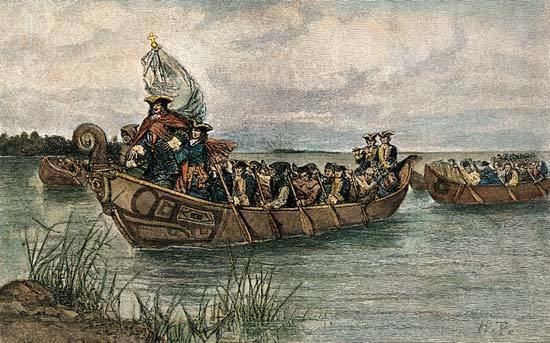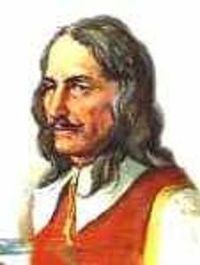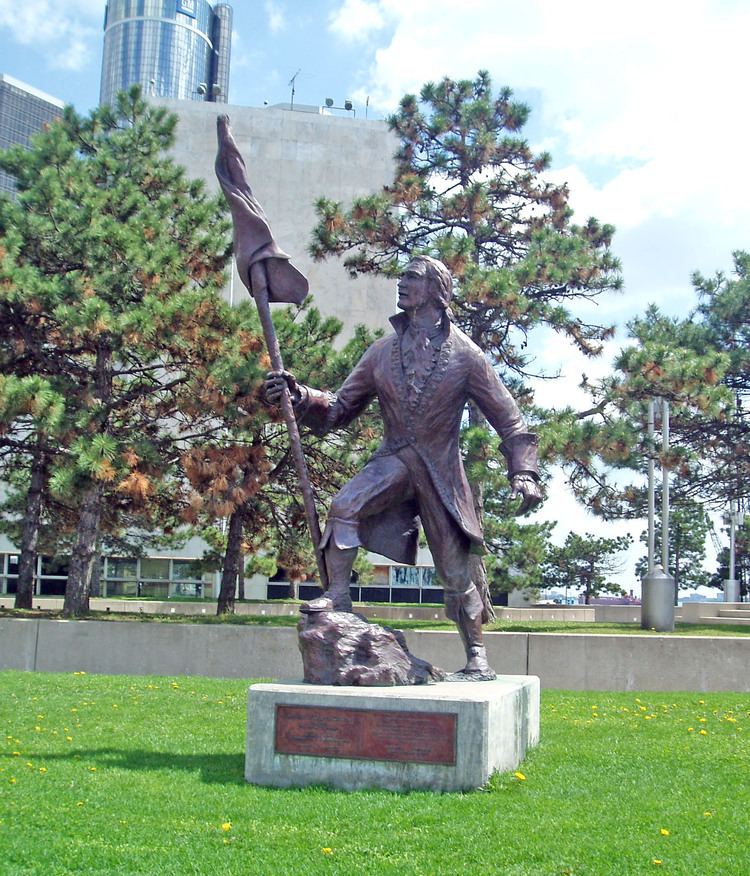Full Name Antoine Laumet Spouse(s) Marie-Therese | Nationality French Name Antoine la | |
 | ||
Resting place Vault of Carmelite Fathers' church Occupation Governor, explorer, adventurer Died October 16, 1730, Castelsarrasin, France | ||
Antoine de la Mothe Cadillac and the Founding of Detroit.
Antoine Laumet de La Mothe, sieur de Cadillac (/ˈkaedilaek/; [kadijak]; March 5, 1658 – October 16, 1730), usually referred to as Antoine de la Mothe Cadillac (aka de la Motte), was a French explorer and adventurer in New France, an area of North America that stretched from present-day Eastern Canada in the north to Louisiana on the Gulf of Mexico in the south. Rising from a modest beginning in Acadia in 1683 as an explorer, trapper, and a trader of alcohol and furs, he achieved various positions of political importance in the colony. He was the commander of Fort de Buade, modern-day St. Ignace, Michigan, in 1694. In 1701, he founded Fort Pontchartrain du Detroit, the beginnings of modern Detroit, which he commanded until 1710. Between 1710 and 1716 he was the governor of Louisiana, although he did not arrive in that territory until 1713.
Contents
- Antoine de la Mothe Cadillac and the Founding of Detroit
- Antoine de la Mothe Cadillac
- Early life
- New France
- Les Douacques
- Michilimackinac 16941696
- Le Detroit 17011710
- Louisiana 17101716
- Castelsarrasin 17171730
- Legacy
- References

His knowledge of the coasts of New England and the Great Lakes area was appreciated by Frontenac, governor of New France, and Pontchartrain, Secretary of State for the Navy. This earned him various favors, including the Order of Saint Louis from King Louis XIV. The Jesuits in Canada, however, criticized his perceived perversion of the "Amerindians", North America's indigenous peoples, with his alcohol trading. La Mothe was imprisoned for a few months in Quebec in 1704, and again in the Bastille on his return to France in 1717.

The city he helped found, Detroit, became the world center of automobile production in the 20th century. William H. Murphy and Henry M. Leland, founders of the Cadillac auto company, paid homage to him by using his name for their company and his armorial bearings as its logo in 1902. Various places bear his name in North America, in particular Cadillac Mountain, Maine, and the town of Cadillac, Michigan.

He was widely hailed as a hero in the popular mind until the 1950s and rethinking of the colonial enterprise. Since then Zoltvany finds, "he most definitely was not one of the 'great early heroes' and probably deserves to be ranked with the 'worst scoundrels ever to set foot in New France.'"
Antoine de la Mothe Cadillac
Early life
Cadillac was born Antoine Laumet on March 5, 1658, in the small town of Saint-Nicolas-de-la-Grave in the French Province of Gascony (today in the Tarn-et-Garonne departement of the Midi-Pyrenees region). His father, Jean Laumet, was born in the village of Caumont-sur-Garonne. He became a lawyer in the Parliament of Toulouse. In 1652 Jean was appointed lieutenant to the judge of Saint-Nicolas-de-la-Grave by Cardinal Mazarin. He was appointed as a judge in 1664. Antoine's mother, Jeanne Pechagut, was the daughter of a merchant and landowner. They were Protestant – French Huguenots, and suffered some discrimination because of that. La Mothe's adult correspondence reveals that his youth included rigorous study at a Jesuit institution where he learned theology, the law, agriculture, botany and zoology.
After his career in North America, he returned to France. In a record of service he filled out in 1675, he said that he had enlisted in the military as a cadet at the age of 17 in the Dampierre regiment, in Charleroi. Two years later in personal letters, however, he reported that he had been an officer in the Clerambault regiment in Thionville, and in 1682 he had joined the Albret regiment, in Thionville.
At the age of 25, Antoine Laumet departed from France to the New World. His father lost a lawsuit against a lawyer in Castelsarrasin that caused him financial difficulties. In addition, he had lost financial support following the death of Cardinal Mazarin and suffered the current intolerance against Protestants. Laumet may have embarked on his voyage by devious means, as historians have not found his name on any passenger list of ships departing from a French port.
New France
In 1683, Antoine Laumet arrived at Port Royal, the capital of Acadia. During the next four years, he explored his new country in all directions, extending his explorations to New England and New Holland, pushing south to the Caroline, now North Carolina and South Carolina, and learning some Native American languages and habits. He probably entered into a business relationship with Denis Guyon, a merchant of Quebec. On June 25, 1687, he married Guyon's daughter, Marie-Therese, 17, in Quebec.
The marriage certificate is the first document that records his new identity. He identified as "Antoine de Lamothe, ecuyer, sieur de Cadillac", and signed as "De Lamothe Launay". Like many immigrants, he took advantage of emigrating to the New World to create a new identity, perhaps to conceal the reasons that drove him from France. This new identity "ne sort pas de son sac" ("I did not create this identity out of nowhere"), as he wrote later. Antoine Laumet likely remembered Sylvestre d'Esparbes de Lussan de Gout, baron of Lamothe-Bardigues, lord of Cadillac, Launay and Le Moutet; adviser to the Parliament of Toulouse. He knew him for at least two reasons: Bardigues, Cadillac, Launay and Le Moutet are villages and localities close to his birthplace, Saint-Nicolas-de-la-Grave, and Antoine's father Jean Laumet was a lawyer in the Parliament of Toulouse.
The sons likely encountered each other during their studies. Second son in his family, Laumet identified with the second son of the baron. He used the phonic similarity between his own name and that of Launay, creating the name: Antoine de Lamothe-Launay. He took the title of ecuyer (squire), the rank held by a family's second son, followed by the title sieur (sire) of Cadillac. This accorded with the Gascon custom whereby the junior family member succeeds the elder son upon the latter's death. Laumet created a new name, identity and noble origin, while protecting himself from possible recognition by persons who knew him in France.
In addition, he presented his own titles of nobility, as illustrated by armorial bearings that he created by associating the shield with the three « merlettes » (birds with no legs or bill) of the baron de Lamothe-Bardigues and that of the Vires family (of France's Languedoc region) Origins of Cadillac Crest.
The marriage prove to be a fertile one. The Lamothe-Cadillac couple had six daughters and seven sons: Judith (1689), Magdeleine (1690), Marie Anne (1701–1701)? (1702–1702), Marie-Therese (1704), Marie-Agathe (December 1707) and Joseph (1690), Antoine (1692), Jacques (1695), Pierre-Denis (1699–1700), Jean-Antoine (January 1707 – 1709), Francois (1709), Rene-Louis (1710–1714).
Les Douacques
In 1688, the governor Jacques-Rene de Brisay de Denonville gave him the concession of the seigniory (estate) of Les Douacques (which later became the town of Bar Harbor, Maine, well known for fishing and lobsters). His concession brought him no income, even from agriculture. Lamothe entered into a trading partnership with officers of Port Royal, an activity facilitated by using a ship owned by his brothers-in-law Guyon. In 1689, he was sent on an expedition in the vicinity of Boston. Upon his return, he asked the governor of Acadia, Louis-Alexandre des Friches de Meneval, for a job as notary, to bring in a minimum income; his request was turned down. Then, Cadillac was introduced to the governor Louis de Buade de Frontenac in Quebec, who sent him on an exploratory mission along the coasts of New England, aboard the frigate L'Embuscade (The Ambush). Strong head winds forced the ship to return to France.
In 1690, Cadillac was in Paris. He became part of the circle of the Secretary of State for the Navy, the marquis de Seignelay, then of his successor Louis Phelypeaux, comte de Pontchartrain, who appointed him officer of marine troops. On his return to Port Royal, LaMothe learned that the English admiral William Phips had seized the city, and that his wife, daughter, and son were being held captives. They were released in exchange for some English prisoners. In 1691, Cadillac repatriated his family to Quebec, but their ship was attacked by a privateer out of Boston, who took possession of all their goods.
Cadillac was promoted to lieutenant in 1692. He was sent with the cartographer Jean-Baptiste-Louis Franquelin to draw charts of the New England coastline in preparation for a French attack on the English colonies. He set out again for France to hand over the charts, together with a report, to the Secretary of State Pontchartrain. In 1693, he got an allowance of 1500 pounds for his work and was sent back on a further mission to supplement his observations. Frontenac promoted him to captain, then lieutenant commander in 1694.
Michilimackinac (1694–1696)
Cadillac was appointed commander of all the stations of the " Pays d'En-Haut " (the upper countries). He left France at the peak of his career to take up his command of Fort de Buade or Michilimackinac, which controlled all fur trading between Missouri, Mississippi, the Great Lakes, and the Ohio valley. Cadillac gave his wife power of attorney to sign contracts and notarize documents in his absence.
In 1695, Cadillac traveled to explore the area of the Great Lakes and to draw up charts. He had the idea of starting a fort in the straits between Lakes Erie and Huron to compete with the English. In Michilimackinac, he came into conflict with the Jesuit fathers, such as Etienne de Carheil, who accused him of supplying alcohol to the Indians. This was prohibited by a royal decree.
In 1696, to mitigate the difficulties of fur trading, the king ordered the closing of all trading posts, including Michilimackinac. Cadillac returned to Montreal. In 1697, he was authorized to return to France to present his project of a new fort on the strait to the Secretary of State Pontchartrain; Frontenac requested that he be promoted to lieutenant commander. However, Canadian notables strongly opposed the project which, they believed, would lead to the ruin of Quebec and Montreal. Only in 1699 did Cadillac get the support of Pontchartrain to implant the new fort; this was authorized in 1700 by the king, who entrusted its command to Cadillac.
Le Detroit (1701–1710)
On July 26, 1701, Antoine de La Mothe-Cadillac founded Fort Pontchartrain and the parish of Sainte-Anne on the straits (" le detroit " in French). He was helped by Alphonse de Tonti. Their wives joined them in October. In 1702, Cadillac went back to Quebec to request the monopoly of all fur-trading activities and the transfer to his authority of the Amerindian tribes in the area of the straits. He became a shareholder in the "Company of the Colony." After return to the straits, he helped in welcoming and settling the native tribes formerly installed at Michillimakinac.
A fire devastated Fort Pontchartrain in 1703. This disaster destroyed all the registers and records. Cadillac was recalled to Quebec in 1704 to face charges of trafficking in alcohol and furs. Although he was imprisoned as a preventive measure for a few months, his name was cleared in 1705. The king guaranteed him all his titles and granted him the fur-trading monopoly he sought. Two years later, Cadillac was charged with multiple counts of abuse of authority; Pontchartrain appointed a representative, Daigremont, to investigate. He formulated an indictment against Cadillac in 1708.
In 1709, the troops stationed on the straits were given the order to return to Montreal. In 1710, the king named Cadillac governor of La Louisiane, the expansive Louisiana (New France) territory, and ordered him to take up his duties immediately, traveling via the Mississippi River.
Louisiana (1710–1716)
Cadillac did not obey. He drew up a general inventory of the straits, and then, in 1711, boarded a ship, with his family, bound for France. In Paris, in 1712, he convinced the Toulouse-born financier Antoine Crozat to invest in Louisiana.
In June 1713, the Cadillac family arrived at Fort Louis, Louisiana (now Mobile, Alabama), after a tiring crossing. The Cadillac family home stood on the north side of Conti Street in Mobile, which was the first capitol of Louisiana. In 1714, Crozat recommended the construction of forts along the Mississippi River, whereas Cadillac wished to strengthen defenses at the mouth of the River and to develop trade with nearby Spanish colonies.
In 1715, Cadillac and his son Joseph prospected in the Illinois Country (Upper Louisiana), where they claimed to have discovered a copper mine, although there is no copper ore in that area. They established a farm and founded the settlement of St. Philippe on the east side of the Mississippi River. Cadillac directed the first mining of lead in present-day Missouri at what is now called Mine La Motte on the west side of the river. The French brought in slaves to work at the mine; they were the first people of African descent in the future state of Missouri. The production of lead was important for ammunition in the colonies. The Southeast Missouri Lead District is still a major source of that metal.
After many arguments, Crozat withdrew any authority Cadillac had in the company. The following year, he ordered Cadillac removed from colonial office.
Castelsarrasin (1717–1730)
The Cadillac family returned to France and, in 1717, settled in La Rochelle. Cadillac went to Paris with his son Joseph. They were arrested immediately and imprisoned in the Bastille for five months. They were released in 1718, and Cadillac was decorated with the Order of Saint Louis to reward his 30 years of loyal services. He settled in the paternal home, where he dealt with his parents' estate.
He also made many trips to Paris to have his rights to the concession on the straits recognized. He prolonged his stay in Paris in 1721, giving another general power of attorney to his wife to sign documents in his absence. He was finally vindicated in 1722. He sold his estate on the straits to Jacques Baudry de Lamarche, a Canadian. The French government appointed Cadillac as governor and major of Castelsarrasin, close to his birthplace.
Antoine de Lamothe-Cadillac died on October 16, 1730 in Castelsarrasin, "around the midnight hour", at the age of 72. He was buried in a vault of the Carmelite Fathers' church.
Legacy
Some of Antoine de Lamothe-Cadillac's far-reaching visions were developed after he had left New France. For instance, Jean-Baptiste Le Moyne de Bienville founded the city of New Orleans, near the mouth of the Mississippi River, in 1718, and it became a major port and city of New France.
The straits became a strategic location. Fort Pontchartrain du Detroit enjoyed an ideal location between the Great Lakes and the river basins. The fort would be succeeded by Fort Detroit and Fort Wayne and by Fort Amherstburg and Fort Malden on the opposite shore.
The car brand Cadillac was named after him and its headquarters was based in Detroit (it has since been moved to New York City), where Cadillac himself explored.
Antoine de la Mothe Cadillac was honored with a 3-cent stamp on July 24, 1951, to commemorate the 250th anniversary of his landing at Detroit in 1701. The stamp's background design depicts Detroit's skyline as it appeared in 1951 and the foreground shows Cadillac's landing at Detroit in 1701.
